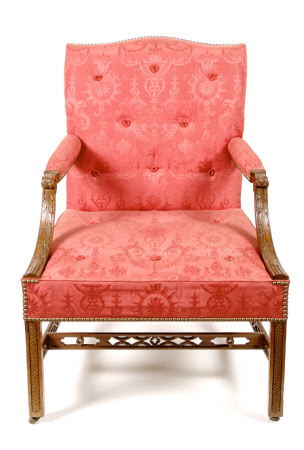The Barn Elms 'Mahogany French elbow chairs, carved neat, welted and quilted and castors.' by William Linnell 1753.
William Linnell (1703-1763)
Category
Furniture
Date
1753
Materials
Mahogany, beech frame, damask and brass studs
Measurements
93 x 67 x 72 cm
Place of origin
London
Order this imageCollection
Montacute House, Somerset
NT 597629.2
Summary
One from a set of nine mahogany and upholstered open armchairs, by William Linnell (1703-1763) London.Commissioned by Sir Richard Hoare (1734-1787) for the drawing room at Barn Elms, Surrey in 1753.Each with an upholstered back with a waved top rail and with padded arms with scroll and acanthus carved terminals held by down swept acanthus arm supports. The overstuffed seat raised on moulded and scale carved square section chamfered legs tied by pierced fret work stretchers, brass castors.
Full description
The chairs were supplied for the drawing room at Barn Elms as a set of ten and were invoiced on 18th September 1753 by William Linnell 'To mahogany French elbow chairs, carved neat, stuffed and covered with your own damask, welted and quilted, and castors to Do, a brass goloss in gold lacker all finest in a very neat manner - £42.0.0...and a large sofa to match - £12.0.0' The chairs and the sofa were probably moved to Stourhead sometime after Sir Richard Hoare’s death in 1787. It is unclear when the tenth chair was lost. The Linnell firm of William and son John, was one of the most prominent firms of cabinet-makers working during the second half of the 18th century, with commissions for a number of important country houses including, amongst others, the Dukes of Beaufort for Badminton House, Sir Robert Child for Osterley Park, the Dukes of Northumberland at Syon Park and Alnwick Castle, the Marquess of Lansdowne at Bowood House and Lansdowne House and the Dukes of Argyll at Inverary Castle. William Linnell was apprenticed as a joiner in 1717 and was admitted to the Freedom of the Joiners Company on 3 June 1729. Linnell began his career as a carver but by the 1760s he had developed the business sufficiently to cover all areas of cabinet-making. For further discussion and extensive research see: Kirkham, Pat ‘The careers of William and John Linnell’ Furniture History Society Vol.3 1967 pp. 29-44 Kirkham, Pat & Hayward, Helena ‘William and John Linnell, Eighteenth Century London Furniture Makers’ Studio Vista, Christies, London 1980 pl.39 & 228 pp.21,78 & 144. James Weedon (January 2018)
Provenance
Commissioned by Sir Richard Hoare (1734-1787) for the drawing room at Barn Elms, Surrey in 1753 from William Linnell (London, 1703-1763). Thence by descent to Richard Colt Hoare (1758 – 1838) and transferred to Stourhead. Bequest to the National Trust of Stourhead Estate and chattels by Sir Henry Hugh Arthur Hoare, 6th Bt (1865 – 1947) in 1946.
Makers and roles
William Linnell (1703-1763), furniture designer and maker
References
Hayward and Kirkham, 1980: Helena Hayward and Pat Kirkham. William and John Linnell, eighteenth century London furniture makers. London: Studio Vista in association with Christie’s, 1980., pl.39 & 228 pp.21,78 & 144 Kirkman, Pat 'The careers of William and John Linnell' FHS
